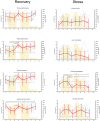Assessment of fatigue and recovery in elite cheerleaders prior to and during the ICU World Championships
- PMID: 36949892
- PMCID: PMC10025303
- DOI: 10.3389/fspor.2023.1105510
Assessment of fatigue and recovery in elite cheerleaders prior to and during the ICU World Championships
Abstract
Introduction: Little is known about the demands of competitive cheerleading. Therefore, the objective of this study was to assess fatigue and recovery during preparation for world championships.
Methods: Fifteen participants from the German senior "All-Girl" and "Coed" national teams (nine males and six women) were recruited. Data were collected during the final preparation (T1 -T7) and competition days (C1 -C2). Heart rate variability (HRV) and resting heart rate (HR) were measured every morning. Data on training load, recovery, and stress (Short Scale for Recovery and Stress) were surveyed after training. Countermovement jump height (CMJ), sit-and-reach, and exercise-induced muscle damage (EMID) scores were taken in the afternoon.
Results: There was a practically relevant decrease in CMJ (T2, T6). A trend for HR to increase (T5-C2) and HRV to decrease (T4, T6-C2) was evident. Through training, recovery decreased and recovered as C1 approached (mental performance: T2-T4 p = 0.004; T2-C1 p = 0.029; T3-T4 p = 0.029; emotional balance: T3-T4 p = 0.023; T3-C1 p = 0.014; general recovery status T1-T3 p = 0.008; T3-T4 p = 0.024; T3-C1 p = 0.041), whereas stress increased during the first days and returned to normal before C1 (emotional dysbalance: T2-T4 p = 0.014; T2-C1 p = 0.009; T3-T4 p = 0.023; T3-C1 p = 0.014). EMID scores increased for the upper and lower body between T3, T5-T7 (p ≤ 0.036) and T3, T6-T7 (p ≤ 0.047), respectively.
Discussion: Pre-competition training led to substantial fatigue, and most markers indicate that athletes do not compete fully recovered. This could possibly be avoided by optimizing the training load or implementing recovery strategies.
Keywords: cheerleading; monitoring; regeneration; stress; training load.
© 2023 Gavanda, von Andrian-Werburg and Wiewelhove.
Conflict of interest statement
The authors declare that the research was conducted in the absence of any commercial or financial relationships that could be construed as a potential conflict of interest.
Figures


Similar articles
-
Impact of vitamin E and selenium on antioxidant capacity and lipid oxidation of cheddar cheese in accelerated ripening.Lipids Health Dis. 2018 Apr 11;17(1):79. doi: 10.1186/s12944-018-0735-3. Lipids Health Dis. 2018. PMID: 29642933 Free PMC article.
-
The Interplay Between Plasma Hormonal Concentrations, Physical Fitness, Workload and Mood State Changes to Periods of Congested Match Play in Professional Soccer Players.Front Physiol. 2020 Jul 21;11:835. doi: 10.3389/fphys.2020.00835. eCollection 2020. Front Physiol. 2020. PMID: 32792977 Free PMC article.
-
[Effects of transcutaneous electrical acupoint stimulation at different times assisted general anesthesia on stress response of patients undergoing open posterior lumbar surgery].Zhen Ci Yan Jiu. 2023 May 25;48(5):481-7. doi: 10.13702/j.1000-0607.20211314. Zhen Ci Yan Jiu. 2023. PMID: 37247862 Clinical Trial. Chinese.
-
[The anesthesiologic value of transcutaneous acupoint electrical stimulation combined with general intravenous anesthesia in endoscopic thyroidectomy patients: a clinical study].Zhongguo Zhong Xi Yi Jie He Za Zhi. 2014 May;34(5):545-8. Zhongguo Zhong Xi Yi Jie He Za Zhi. 2014. PMID: 24941841 Clinical Trial. Chinese.
-
Interaction between the leg recovery test and subjective measures of fatigue in handball players: short-, mid-, and long-term assessment.Front Sports Act Living. 2024 Dec 19;6:1474385. doi: 10.3389/fspor.2024.1474385. eCollection 2024. Front Sports Act Living. 2024. PMID: 39749264 Free PMC article.
Cited by
-
Individual factors determine landing impacts in rested and fatigued cheerleaders.Front Sports Act Living. 2024 Aug 13;6:1419783. doi: 10.3389/fspor.2024.1419783. eCollection 2024. Front Sports Act Living. 2024. PMID: 39193490 Free PMC article.
-
A systematic review of cheerleading injuries: epidemiological characteristics, biomechanical mechanisms, and prevention strategies.Front Public Health. 2025 Jul 9;13:1614164. doi: 10.3389/fpubh.2025.1614164. eCollection 2025. Front Public Health. 2025. PMID: 40703179 Free PMC article.
References
-
- International Cheer Union. “History of Cheer”. Available at: https://cheerunion.org.ismmedia.com/ISM3/std-content/repos/Top/2013_Webs... (Accessed: October 27, 2022) (2013).
-
- International Cheer Union. “What is the ICU”. Available at: https://cheerunion.org/about/about/ (Accessed: October 27, 2022) (2022).
-
- German Olympic Sports Confederation. “Bestandserhebung 2018: Fassung vom 1. November 2018”. Available at: https://cdn.dosb.de/user_upload/www.dosb.de/uber_uns/Bestandserhebung/BE... (Accessed: October 28, 2022) (2018).
LinkOut - more resources
Full Text Sources
Miscellaneous

